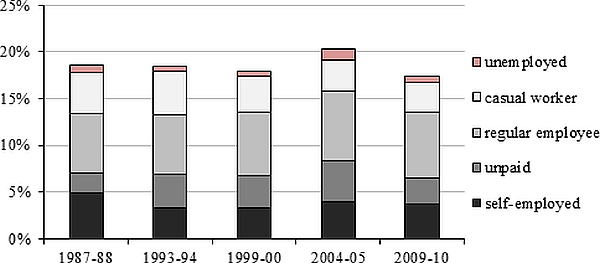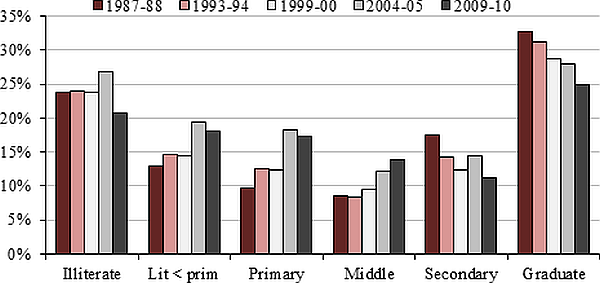Over the past two decades, urban India has experienced expansion in women’s education, fertility decline and growth in white-collared jobs. Then why is it that female labour force participation has stagnated at around 18% since the 1980s? This column seeks to answer this question by exploring demand and supply side factors that influence female labour force participation.
India's economy has grown fast over the past two decades, with the services sector accounting for a large share of growth (Bosworth and Collins 2008; Shastry 2012). India has also experienced a sizable fertility decline, a rapid education expansion and a decline in the education gender gap, while the labour market returns to education increased (Kijima 2006; Pieters 2010). Against this background, it is puzzling to see that the reported female labour force participation rate in urban India has stagnated at around 18% since the 1980s (Figure 1). A cross-country study across years during 1980-2010 by Gaddis and Klasen (2013) shows that this level is fully 20 percentage points lower compared to countries at similar income levels. Moreover, one would have expected a rising share of women to enter the labour force, especially in urban India where women have gotten much more educated, where fertility decline was most pronounced, and where white-collar jobs are concentrated.
Figure 1. Urban female labour force participation rate
 Note: Sample comprises married women aged 25-54. Self-employment includes employers and own account workers. Unpaid refers to unpaid family workers. Source: National Sample Survey Employment and Unemployment Survey.
Note: Sample comprises married women aged 25-54. Self-employment includes employers and own account workers. Unpaid refers to unpaid family workers. Source: National Sample Survey Employment and Unemployment Survey. Analysing the stagnation of female labour force participation rates
Using data from five National Sample Survey (NSS) Employment and Unemployment Surveys spanning 1987-1988 to 20092010, we investigate the proximate causes of this surprising stagnation of female labour force participation over the past 20 years (Klasen and Pieters 2013). After carefully checking whether this low level might be related to undercounting of female activity (for which we find little evidence), we first note that there is a U-shaped pattern of the association of female education with female labour force participation. As shown in Figure 2, this means that at very low levels of female education, activity rates are high. They are much lower at medium education levels, and rise again at higher levels. Over time, this U has gotten more muted and shifted to the right: the low point has shifted from middle school education to secondary education, while the increase at graduate level is now much smaller than it was in 19871988. In contrast, male participation rates areclose to 100% and do not differ by education level.
Figure 2. Urban female labour force participation rate by education level
 Note: Married women age 25-54. Secondary schooling includes higher secondary education. Source: NSS Employment and Unemployment Surveys.
Note: Married women age 25-54. Secondary schooling includes higher secondary education. Source: NSS Employment and Unemployment Surveys. What drives women’s labour force participation?
Labour supply as well as labour demand effects could account for the stagnation in participation rates. Among the labour supply effects, rising male incomes and education might serve to lower female participation due to the well-known income effect; rising household incomes lead women to reduce their participation as the necessity for them to work in order for the family to survive reduces. In addition, there might be stigmas and social restrictions against employment of educated women in certain menial and blue-collar jobs. At the low level of the education distribution, economic distress overrides these concerns. Fertility decline should promote female participation. Lastly, it might be the case that the education expansion has been less oriented towards labour market activities than one might presume. In particular, it could be the case that the rapid expansion of female higher education is associated with a declining (unobserved) labour market orientation; also, part of the female education expansion might have been aimed at improving the marriage rather than the labour market prospects of women.
At the same time, demand-side effects can play a role. In particular, employment opportunities for jobs typically occupied by educated women (particularly white-collar jobs in service industries, including health, education and public service) might have grown less than the supply of educated workers, leading to fewer women entering the labor force. Thus the relative growth in demand and supply (at the local level) of these types of jobs might affect participation rates.
Accounting for the stagnation
Our analysis of the above mentioned demand and supply side effects suggests that both types of effects have played a quantitatively significant role in accounting for this surprising stagnation of female participation rates at low levels in urban India1. Among the supply effects, rising education and incomes of husbands has served to significantly lower female participation rates, particularly for women with low and intermediate schooling. In addition, a strong stigma against blue collar and menial work for women with medium levels of education has persisted and has had a negative effect on their participation. The presence of parents in law in the household also serves to lower female participation.
While fertility decline and rising own education helped to increase female participation, the positive impact of female graduate education on employment has fallen significantly over time. We find evidence that this is related to a falling tendency of only women with great labour market orientation to opt for graduate education. As a broader section of Indian women have enjoyed graduate education, many of them have a lower labour market orientation than those few who had a graduate degree in 19871988. We also find evidence suggesting that part of the expansion of education has been to improve marriage prospects of women, rather than their employment prospects. In order to have a reasonable probability to attract a well-educated and high-earning spouse within the same caste group and state, women have had to acquire significantly more education than before.
But also demand-side factors have played a role. In particular we find evidence that the local economic structure matters. If local employment has expanded in areas that are not considered suitable for women, female activity rates have stagnated or declined.In addition, in districts where the graduate share of the working age population is particularly high, female activity rates have fallen. Thus, there appears to be a (local) oversupply of highly educated workers, relative to the growth in jobs considered appropriate by and for educated women.
Implications
The results point to some worrying implications. First, these low participation rates imply that India is unlikely to reap the demographic dividend associated with its currently favourable demographic constellation of a rising share of the working age population (relative to young and old dependents). In East Asia, this demographic dividend has been estimated to have accounted for up to a third of per capita growth rates in the past 30 years (Bloom and Williamson 1998). High and rising female participation was a key element of that effect which is not present in India; this could seriously undermine India’s growth prospects. Second, there is an overwhelming literature demonstrating the empowering effects of female employment and earnings on their bargaining power, with positive impacts on their well-being as well as that of their children. If India’s growth is not drawing women in, these empowerment effects will not materialise.
Some policy implications suggest themselves. On the demand side, the pattern of growth matters. Employment growth in urban India has been concentrated in construction and low-skilled services, but from the perspective of female labour force participation a different growth strategy would be warranted; a more female-intensive export-oriented growth strategy (as has been pursued in many East Asian economies as well as in neighbouring Bangladesh) would substantially increase female employment opportunities for those in the middle of the education distribution. On the supply side, policies explicitly promoting the acceptability of female employment outside the public sector, policies to allow a greater compatibility of female employment with domestic responsibilities, and policies to improve the safety of female workers in the private sector could also draw more women into the workforce. Ultimately, however, values and attitudes towards female employment will need to change in order to change this state of affairs. This includes the acceptance of female employment also for women with children and greater acceptance of female employment in traditionally male-dominated fields. In this sense, a politicisation of the issue might be key.
Notes:
- We specify an econometric model that considers these demand and supply effects. We then use the estimation results to decompose the changes in female participation rates into the different drivers. It is a reduced form model in the sense that the effect of own-wages is not included in the estimation. Different ways to estimate these effects does not change the results we present here. In any case, labour market returns to education have increased across the board (but more so at higher levels of education) so that these changes in returns should have promoted (rather than discouraged) female participation.
Further Reading
- Bloom, D. E. and J. G. Williamson (1998), “Demographic Transitions and Economic Miracles in Emerging Asia”, World Bank Economic Review, 12(3), 419-455.
- Bosworth, B. and S. M. Collins (2008), “Accounting for Growth: Comparing China and India”, Journal of Economic Perspectives, 22(1), 45-66.
- Gaddis, I. and S. Klasen (2012), “Economic Development, Structural Change, and Women’s Labor Force Participation: A Re-Examination of the Feminization U Hypothesis”, Courant Research Center Working Paper No. 71, University of Göttingen, forthcoming in Journal of Population Economics (2013).
- Kijima, Y. (2006), “Why did wage inequality increase? Evidence from urban India 1983-99”, Journal of Development Economics, 81(1), 97–117.
- Klasen, S. and Janneke Pieters (2013), “What explains the stagnation of female labor force participation in urban India?”, Courant Research Centre, Discussion Paper No. 146. http://www2.vwl.wiso.uni-goettingen.de/courant-papers/CRC-PEG_DP_146.pdf
- Pieters, J. (2010), “Growth and Inequality in India: Analysis of an Extended Social Accounting Matrix”, World Development, 38(3), 270-281.
- Shastry, G. K. (2012), “Human Capital Response to Globalization: Education and Information Technology in India”, Journal of Human Resources, 47(2), 288-330.




 27 September, 2013
27 September, 2013 





Comments will be held for moderation. Your contact information will not be made public.